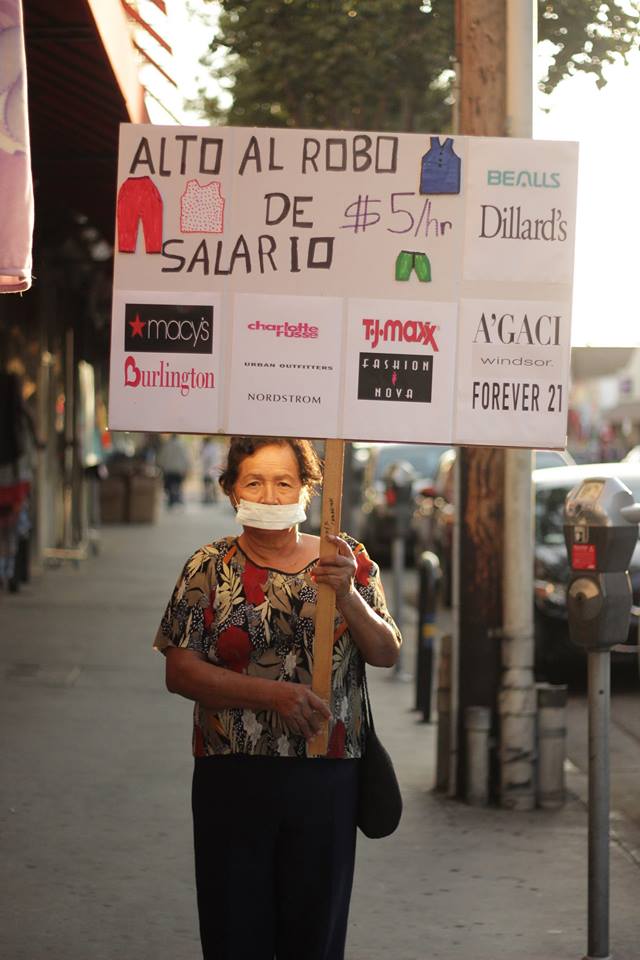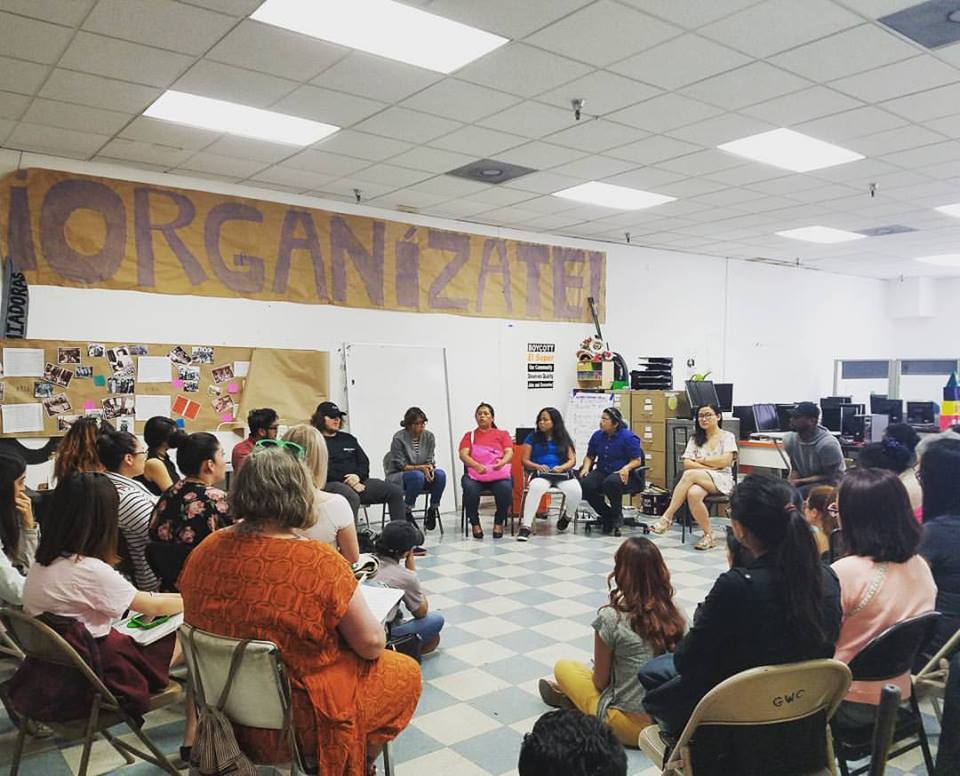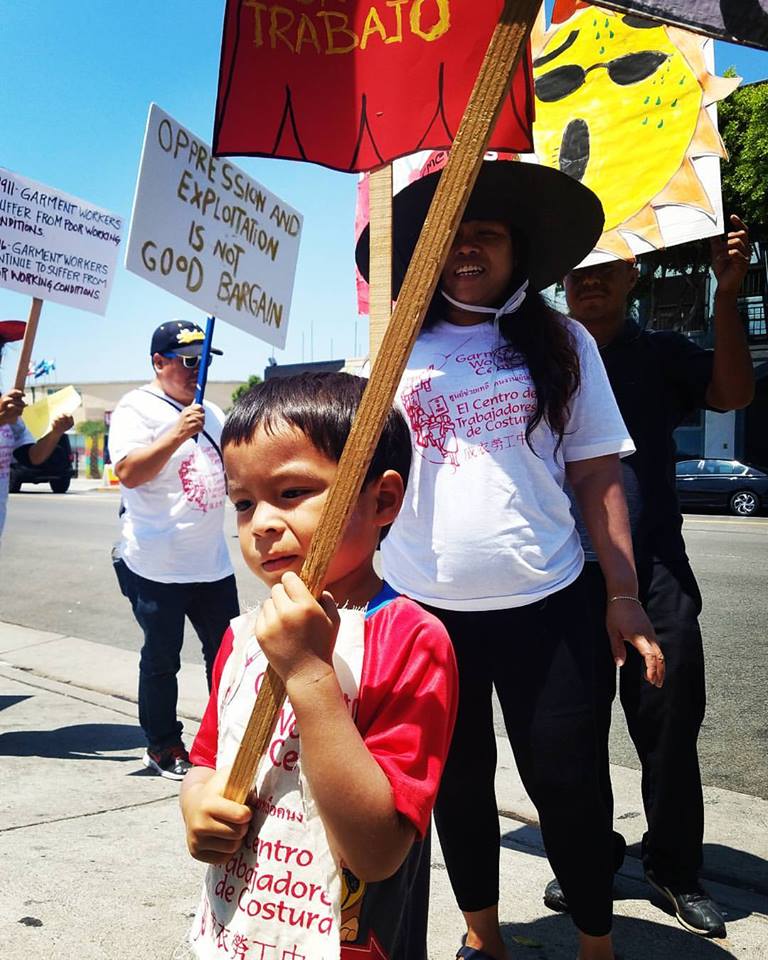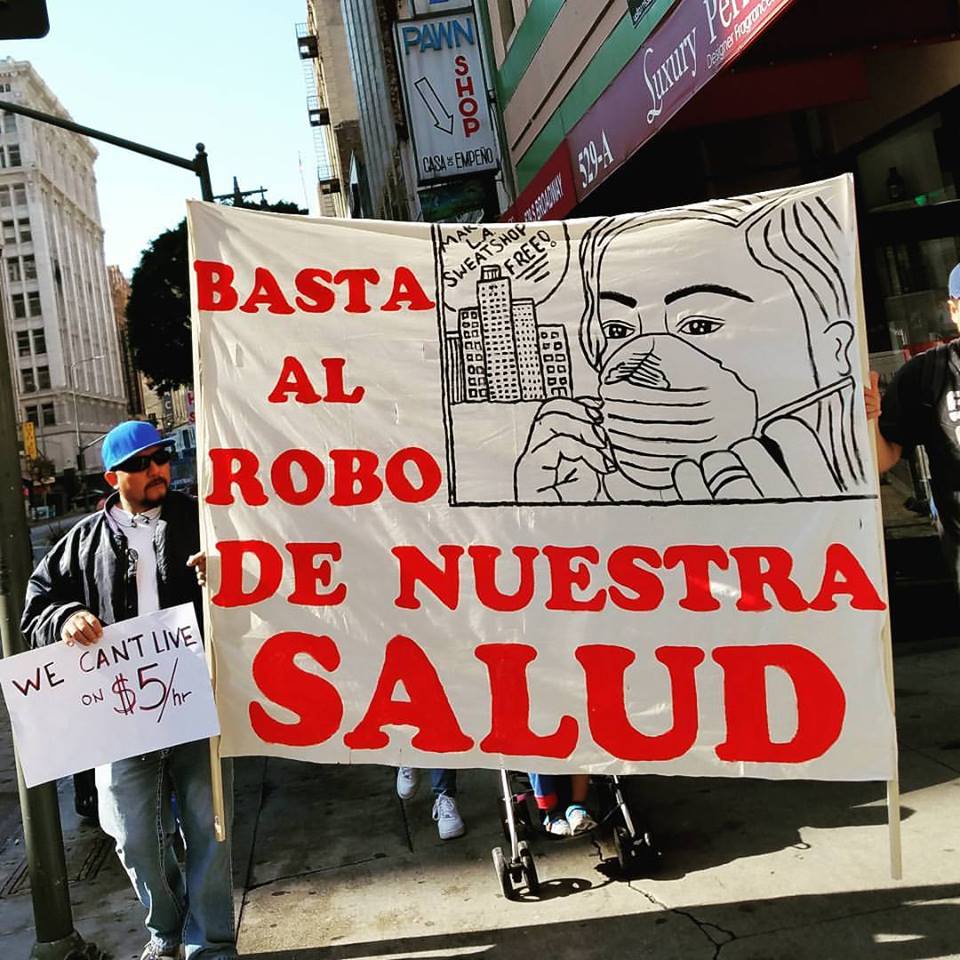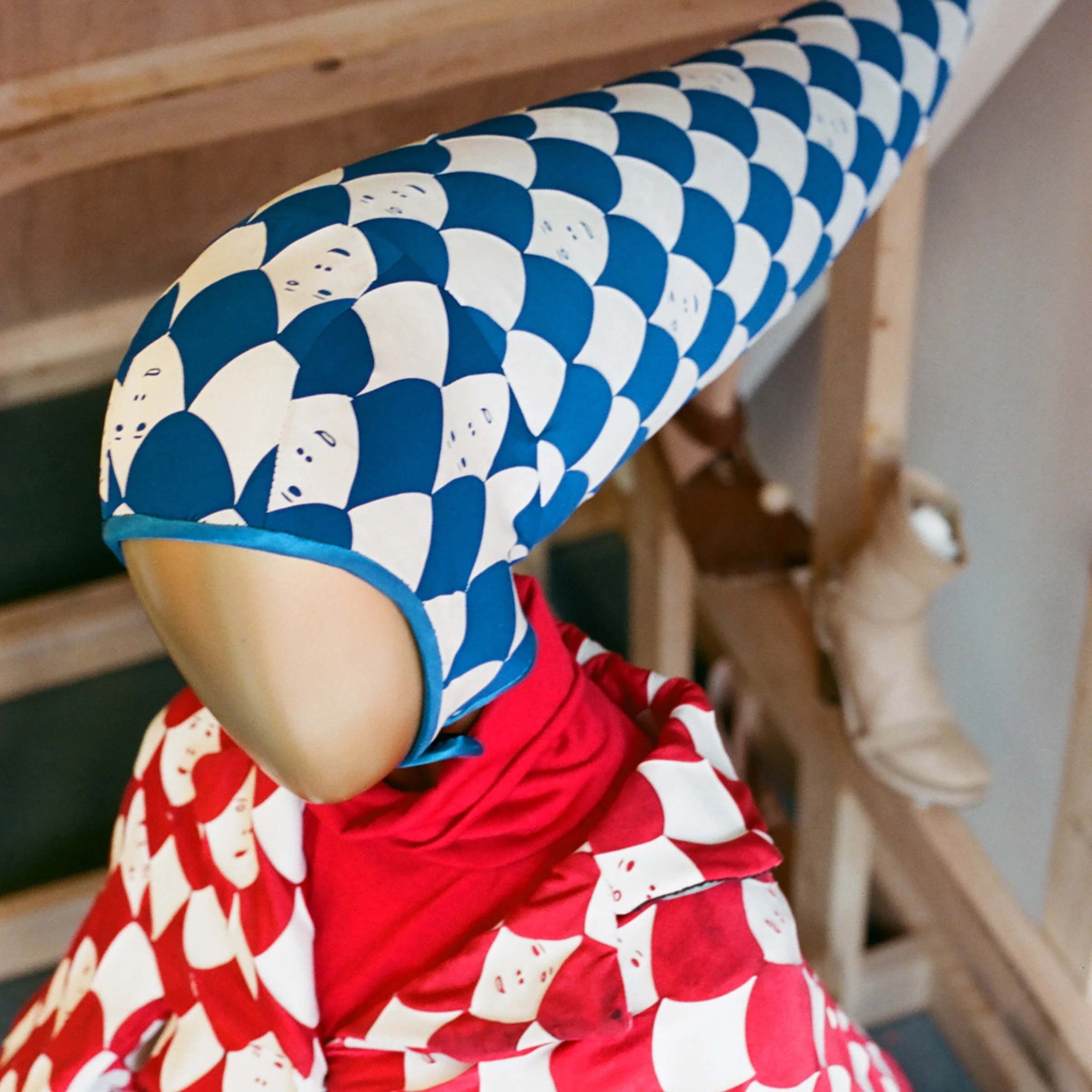Mar Martinez
In a single room studio in downtown Los Angeles, the Garment Worker Center exists as the only organization in the United States exclusively dedicated to the rights of garment workers. Although New York City is considered this country’s fashion capital, the majority of domestic clothing manufacturing happens in Los Angeles. According the Bureau of Labor Statistics’ May 2016 report, there are an estimated 20,000 sewing machine operators working in Los Angeles County in comparison to about 13,000 sewing machine operators in New York City.
I spoke with Mar Martinez, Organizing Coordinator at the Garment Worker Center about why Los Angeles is the epicenter of our country’s fight for garment worker’s rights and the history of this ongoing battle.
Why is clothing manufacturing such a major industry in Los Angeles?
Los Angeles is special for a lot of reasons. It has the infrastructure to do large garment production. There are designers here. And the main thing is the city is really close to the ports.
Many of the manufactures that produce in Los Angeles also produce overseas. Maybe five percent of their production is made here. These companies keep production here because it’s convenient and there’s a fast turnaround when producing in Los Angeles. Maybe they missed an order or they need something quickly. They’ll produce it here and it’ll be done in a week or two weeks. Production will stay here for that reason.
Take Forever 21, for example. Only about five percent of their production is in Los Angeles. Why is it so hard for them to pay five percent of their garment production the local minimum wage? The reason is because they don’t want to admit liability. They don’t want to be held responsible for wages because they’re afraid that that’ll mean that they’re responsible for working conditions in Bangladesh and China. Which in my opinion, they should be monitoring and paying workers right all over the world. But here in Los Angeles, we have a much higher minimum wage and a higher standard of living. Five dollars an hour is not going to cut it for garment workers living in Los Angeles.
Why doesn’t the hourly minimum wage apply to garment workers?
Garment workers are paid by piece as opposed to hourly. This system is called the “piece rate.” They are paid the same three cents to ten cents per piece that garment workers were paid over 30 years ago. They’ll get maybe three cents per trimming or ten cents for sewing in a zipper because it’s more complicated. Even though the hourly minimum wage has increased over and over again, the retailers are paying the same piece rates to the manufacturers who are paying the same rates to the production contractors. None of that has increased. And now the hourly minimum wage is going to go up to $15 in 2020.
In the next three or four years, the country’s minimum wage is going to increase so much. What are we doing about the prices the manufacturers are paying? What are we doing what about the prices that retailers are paying? And how are we increasing the piece rate for workers? If they’re going to stay on the piece rate!
I think the piece rate should be eliminated completely. It’s a way to keep workers under high pressure and make them work at unsafe speeds. It creates unhealthy competition amongst the workers that is bad for unionization and organizing. And not only that, it causes subminimum wages.
Where are the unions? Why isn’t there a union for garment workers?
One hundred years ago, the garment industry was one of the pillars of the unionization movements in the United States. I always tell people that the garment industry is where the antiunion movement perfected itself. The garment industry is where globalization got its training.
Garment industry unionization movements were strong after Triangle Shirtwaist Factory fire in 1911. [1] There was amazing organizing happening. But when workers began organizing in the Northeast, the factories ran to the South to The Bible Belt and then exploited black garment workers in the South.
When the unions noticed and began organizing the workers in the South, the factories bolted to the Southwest, where the factories are now. They exploited undocumented Mexican workers. Each time the factories moved to a new region, they did a blow to the unionization movement. They destroyed the garment workers union movement in the Northeast and the South. The organizing tried to come here. They tried to do union drives in factories here. There’s a lot of drama with the unions and how they all dealt with globalization. The last big blow to the domestic garment industry was the expiration of the Multi Fibre Arrangement (MFA) in 2005. [2]
The expiration of the MFA led to Bangladesh becoming the city with the lowest global minimum wage and the largest garment production over one or two years. Buildings like Rana Plaza were created overnight with really bad construction that led the factory collapse. An earthquake didn’t cause the Rana Plaza tragedy. [3] That was a poorly constructed building collapse.
After the MFA expiration, the number of garment workers in Los Angeles got cut in half. Forever 21 was producing about 90% of their garments in Los Angeles. Today they’re only producing like 5%. Because of the loss of jobs, the pressure increased for wages. Rights for garment workers in Los Angeles have gotten worse over the last 15 years. Unions left and they lost interest in this industry.
I call the garment industry the “white noise of our society.” We all know that everything we’re wearing is made in sweatshops, but we kind of put it in the back of our mind. We don’t think about it. And that’s essentially what’s happening here in the LA garment industry, the second largest industry in this city. But in Los Angeles, it’s just white noise to everyone that lives here.
What’s the relationship between the worker’s citizenship status and the fight for fair wages?
One of the reasons that this industry is white noise is because many garment workers are undocumented workers. They don’t vote! Who cares about them, right? At least that’s the way they see it. The garment manufacturing industry is the backbone of Los Angeles. But consumers don’t care about the actual conditions that the workers are producing in.
Everybody assumes that all the clothes that are made in LA are made like American Apparel, and it’s not. American Apparel was absolutely the exception. And even then, they had a lot of messed up antiunion politics, a lot of harassment and all those horrible things that come with the garment industry. People talk about Dov Charney and how he harassed his employees. Do you know how many garment workers have been sexually harassed by their employers?
And we’re trying to bring all this stuff to light, and we’re trying to make people know what the real problems are. A lot of people think that we need a fair trade label or something like that in LA, and that’s going to solve the issue. But it’s not. If that were true, then American Apparel would have saved the garment industry and it didn’t. In fact, it just kind of created a stark contrast.
What brought you to working in this role at GWC?
I’ve been an organizer for a while. I grew up in South Central, Los Angeles. I went to Freemont High School, which was then one of the most crowded high schools in LA. I started organizing in high school around the budget cuts that were happening in the Los Angeles Unified School District. I got involved in organizing, back in the day, with Community Coalition and this group called South Central Youth Empowered through Action.
And then I went to college at Brown University. The group there was called Student Labor Alliance. So, it was a group of students that supported the workers in the dining service and the libraries, who were basically the people of color on campus. There were obviously students of color that were attending Brown. But the majority of the people of color at the university were working there as janitors and dining service folks. And they were migrants and I identified with their struggles based on my family’s struggles.
Eventually that organization led me to United Students against Sweat Shops. There was a campaign for kicking Adidas off campus because Adidas had shut down a factory in Indonesia, running away from paying workers fair wages and the union movement that was built there. With this campaign, we were successful in getting Brown University not to renew its contract with Adidas.
With USASS I got to travel as part of a delegation. We went to Bangladesh and I went to Nicaragua to talk to workers that worked for Adidas. In Bangladesh, I talked to the Rana Plaza factory survivors. They were all really super impactful experiences for me. But the thing that was most impactful was being able to connect it to the conditions that my mom and dad had grown up being in with the garment industry here in Los Angeles.
It was really like building from the ground up from the moment I started working at the Garment Worker Center. We started doing the wage clinic weekly as the way to recruit members. It quickly became a question of, how do we make the laws better for workers?
When a worker filed a wage claim against their boss, it could take a year before you had your first meeting with your employer. By that point, the factory has shut down. And so, these companies were used to these things being dragged on. So, you filed a wage claim and nothing would happen for a year.
At the wage clinic, we educate them on their rights. We talk about what happens in the workplace. We talk about what are the major violations at work. And then we help them file a claim against their employer, if that’s what they want to do. Or, we help them seek some other form of justice like confronting their boss.
What’s the history behind the Garment Worker Center?
The center opened its doors in 2001. It started with the Thai El Monte slavery case. [4] There was a group of people that were involved in that case, including Julie Su who is currently the Labor Commissioner of California. That group formed Sweat Shop Watch.
They agreed that there needed to be a space, a physical place where workers can go and ask for help. The GWC really took off with the campaign to create the Garment Worker Protection Act, a California law known as AB 633, which requires that manufacturers are liable for wage violations. That law is what allows us to at least go after the manufacturers for wage violations. Because we do know that it’s the pricing, the pricing that they pay the contractors is the real problem.
There are four paid positions at the Garment Worker Center, it’s mostly run by volunteers. Out of all the worker’s centers we’re probably the folks that deal with one of the biggest industries in LA but we’re also at the same time the smallest center. We’re not a union and we’re not a traditional non-profit. We do a lot of labor style organizing, advocacy, service and education. But we’re not a typical non-profit that just focuses on policy work. It’s more than that.
A lot of folks will say, “A lot of stuff you’re doing is the job of the government. It’s the government’s job to monitor or talk to workers.” But there’s a gap. And the gap exists because this is a neglected industry, they are undocumented workers that don’t trust the government and don’t necessarily feel safe. The idea is that conditions are supposed to be better in the US than anywhere else. And the reason is we have laws and enforcement that make it that way. The reality is that these companies are above the law in a lot of ways. They exist in a world of their own. They’ve created loopholes and carved themselves a niche in the law for themselves.
Who are the GWC allies apart from the foundations that give you financial support?
There are two types of allies that we have. We have all of the folks in the immigrant rights movement. We’re starting to build alliances with the folks that are doing anti-prison work because we were talking about how there are garment workers in prisons. And there’s the alliances that come from the consumer activism, the folks that are interested in ethical clothing, environmentally friendly clothing, and stuff like that.
What about fashion schools or fashion designers?
We’ve definitely got a lot of outreach from them. I think the challenging thing with that is again, we’re a small staff but there is a lot of education that we have to do with those folks. A lot of fashion students coming outraged at what’s going on without really having an analysis, or letting workers lead their work, or listening, or coming in with their own opinions without listening to what the problems are. That’s also been a challenge. Even when folks like that come and they don’t come often, we also have to sit down and just have a talk about what does it mean to talk to workers and how to not exploit workers for their knowledge and things like that.
Our biggest volunteer allies have been the kids of garment workers much like myself. A lot of folks that end up going in high school or in college that apply to internship or things like that even just call us to volunteer. And they are all like, “My Mom went through all of this,” or, “I’m helping my Mom file a wage claim,” or, “I’m helping my Dad file a wage claim. Can you help me?” And that person ends up being really interested in wanting to volunteer.
Because as bad as things are, the reality is these folks need these jobs to survive. A lot of folks are escaping poverty by coming to the garment industry and having these jobs. And a lot of workers are filing wage claims and a lot of workers are speaking out and they are being retaliated against.
What really works is when our allies, our community, or consumers, join our movements. Because it gives us power. These brands are like, “I don’t want them to target us because they have this community that follows them.” It gives us power when folks do their consumer activism and don’t shop in these places. Or, send letters to these companies that are like, “I heard from garment worker’s center that you’re doing this and that. What’s up with that? I want you to change. I’m not going to shop here until you respond to their demands.” Things like that are helpful in supporting workers.
We are strategically targeting companies for a reason because we have a campaign around it, we have research behind it, and we have workers that are organizing around it. So, I always tell people just support workers, just support them and their fights. That’s the most important thing you can do to fight these conditions.
If you are interested in getting involved with the Garment Worker Center, visit their website here, or donate directly.
Notes
[1] The Triangle Shirtwaist Factory in lower Manhattan on March 25, 1911 killed 146 workers, many of who were young women who recently emigrated from Europe. The unsafe working conditions in the factory caused the fire to spread quickly and trapped many of the workers. The Triangle Shirtwaist Factory fire was the deadliest workplace tragedy in New York City until the World Trade Center attacks in 2001.
[2] The Multifibre Arrangement controlled global trade in textiles and garments from 1974 through 2004. The agreement set limits on the amount of textiles and garments exported from developing countries to developed countries. It expired on January 1, 2005.
[3] On April 24, 2013 the five-story Rana Plaza building collapsed in Bangladesh. With a death toll of 1, 134 people, it is the deadliest garment-factory tragedy in history. Factory owner, Sohel Rana, was sentenced to three years of imprisonment in August 2017 for corruption charges.
[4] On August 2, 1995 several government agencies conducted a raid at a mark shift garment factory in El Monte, California. 72 Thai garment workers were found living in California under conditions of slavery.

